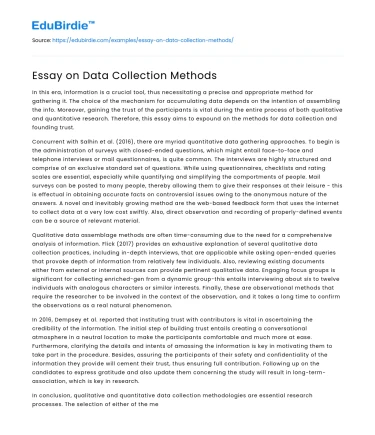In this era, information is a crucial tool, thus necessitating a precise and appropriate method for gathering it. The choice of the mechanism for accumulating data depends on the intention of assembling the info. Moreover, gaining the trust of the participants is vital during the entire process of both qualitative and quantitative research. Therefore, this essay aims to expound on the methods for data collection and founding trust.
Concurrent with Salhin et al. (2016), there are myriad quantitative data gathering approaches. To begin is the administration of surveys with closed-ended questions, which might entail face-to-face and telephone interviews or mail questionnaires, is quite common. The interviews are highly structured and comprise of an exclusive standard set of questions. While using questionnaires, checklists and rating scales are essential, especially while quantifying and simplifying the comportments of people. Mail surveys can be posted to many people, thereby allowing them to give their responses at their leisure - this is effectual in obtaining accurate facts on controversial issues owing to the anonymous nature of the answers. A novel and inevitably growing method are the web-based feedback form that uses the internet to collect data at a very low cost swiftly. Also, direct observation and recording of properly-defined events can be a source of relevant material.
Save your time!
We can take care of your essay
- Proper editing and formatting
- Free revision, title page, and bibliography
- Flexible prices and money-back guarantee
Qualitative data assemblage methods are often time-consuming due to the need for a comprehensive analysis of information. Flick (2017) provides an exhaustive explanation of several qualitative data collection practices, including in-depth interviews, that are applicable while asking open-ended queries that provoke depth of information from relatively few individuals. Also, reviewing existing documents either from external or internal sources can provide pertinent qualitative data. Engaging focus groups is significant for collecting enriched-gen from a dynamic group-this entails interviewing about six to twelve individuals with analogous characters or similar interests. Finally, these are observational methods that require the researcher to be involved in the context of the observation, and it takes a long time to confirm the observations as a real natural phenomenon.
In 2016, Dempsey et al. reported that instituting trust with contributors is vital in ascertaining the credibility of the information. The initial step of building trust entails creating a conversational atmosphere in a neutral location to make the participants comfortable and much more at ease. Furthermore, clarifying the details and intents of amassing the information is key in motivating them to take part in the procedure. Besides, assuring the participants of their safety and confidentiality of the information they provide will cement their trust, thus ensuring full contribution. Following up on the candidates to express gratitude and also update them concerning the study will result in long-term-association, which is key in research.
In conclusion, qualitative and quantitative data collection methodologies are essential research processes. The selection of either of the methods is dependent on the type of information. Additionally, it is worth establishing and maintaining a healthy relationship with potential participants.






 Stuck on your essay?
Stuck on your essay?

